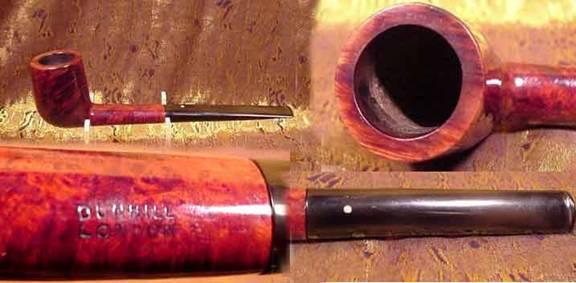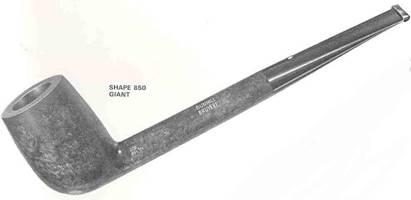An eBay ES
Une ES sur eBay Par John C. Loring
Mis à disposition et traduit par Jean-Christophe Bienfait
Je suppose que d'abord et avant tout, eBay est un endroit pour acheter des pipes, mais de plus en plus pour moi c'est autant un endroit pour en apprendre sur les pipes. En voici un cas typique :
“Cette Dunhill Bruyere à la tige ovale mesure 6" de long (15,24 cm) avec une hauteur du foyer de 1-3/4" (4,45 cm). "La bruyère est exceptionnelle et porte le marquage “H.W./o” (hand-worked c.a.d. fait main).Le tuyau est d'origine avec le point en ivoire. Nomenclature : le côté gauche de la tige est marqué “H.W./o” et “Dunhill London”. Le côté droit de la tige est marqué Made in England Inner Tube Pat. No. 58---/123 ES 6. A noter que la nomenclature est atténuée par le polissage mais reste lisible sauf pour une partie des chiffres du numéro de brevet. Le /123 à la fin du numéro de brevet possède un 3 de taille plus petite et souligné. Le tuyau a des traces de dents en dessous (voir photo). La bruyère est en excellente condition, les parois intérieures du foyer sont lisses. L'Inner tube en métal d'origine est manquant”
Alors que j'écris ces lignes, l'enchère e-bay est déjà close et bien sûr je n'ai pas eu la pipe en main. La description de la nomenclature dit clairement que la pipe est une ES c.a.d. une Canadienne de 1923. Mais un coup d'œil aux images (regroupées ici) soulève plus qu'un point d'interrogation.
Je suis au fait de la nomenclature, elle ne m'est pas étrangère, je ne regarde rien d'autre au début et ce qui m'attire l'œil cette fois c'est que le marquage DUNHILL / LONDON semble avoir les deux termes de la même longueur, ce qui fait penser à une datation rare de la fin 1918, nonobstant la note écrite mentionnant un code date de 1923. Une escroquerie sur e-bay???
En revenant toutefois sur la pipe en elle-même, quelque chose ne semble pas tourner rond. La pipe est censée être une Canadienne ES. Les dimensions hors tout de la pipe correspondent aux ES de cette période mais l'image montre un rapport tige/tuyau très curieux – On pourrait penser que la première devrait être nettement plus longue et le second plus court, au moins quand on les compare avec des exemples de 1920 et 1921 tirés de ma collection, et celui qui figure dans un catalogue Dunhill de 1925. C'est certainement suspect bien que pas absolument concluant, par exemple ci-dessous figure une canadienne ODA 850 d'un catalogue Dunhill de 1968 avec tige courte et tuyau long inhabituels :
still even with that unusual ODA 850 the short shank is longer then the long bit, while here the short shank is clearly shorter then the long bit. Yet another consideration is that there were some dramatic changes in at least a few early Dunhill shapes, for instance the 151 I have written about previously. On the other hand “ES” likely was meant to signify “Extended Shank” and if so the pipe at hand can hardly be considered representative.
So lets take a closer look: First, its clear that this pipe has been ‘cleaned up’ probably, more then once, note the ‘weak nomenclature’ description: the clean bowl top, a recently reamed bowl interior and probably an earlier slightly off center reaming. This is a well smoked not a lightly smoked pipe. Second, while scans can sometimes be ‘off’, the DUNHILL / LONDON stamp, particularly the DUNHILL, seems to have been stamped with individual letters rather then a single two word block stamp. Third, the DUNHILL / LONDON seems stamped low on the shank, toward the bit, rather then somewhat centered as with my other early ESs. If you mentally adjust the pipe by extending the shank to center the nomenclature and shorten the bit accordingly, you end up with a pipe that begins to be in line my early ES examples. Fourth, note the bit diameter at the shank/bit meeting point – it appears slightly larger then that of the shank. Fifth, while sometimes difficult to judge, the white dot on the bit seems to me to be a bit large for 1918 as opposed to the early 1920s.
Add to this my general observations that during this early period Dunhill (i) datecoded its repairs: (ii) attempted to preserve or replicate original stampings (including the original datecode) as part of the repair; and (iii) (based on a few other examples and the factory stamping log) did not have most of the 1910’s stamping tools in the 1920’s (thus forcing later replications to be stamped by individual letters). My conclusion readily comes to mind, to wit:
It is most likely a 1918 ES, the shank of which was cracked or broken off around 1923 and repaired at the Dunhill factory by amputation and refitting with a new longer bit. The 1923 repair effectively lost the essence of the ES shape, but the pipe still remains marginally collectible because of its early date.
Back to Loring's articles here

